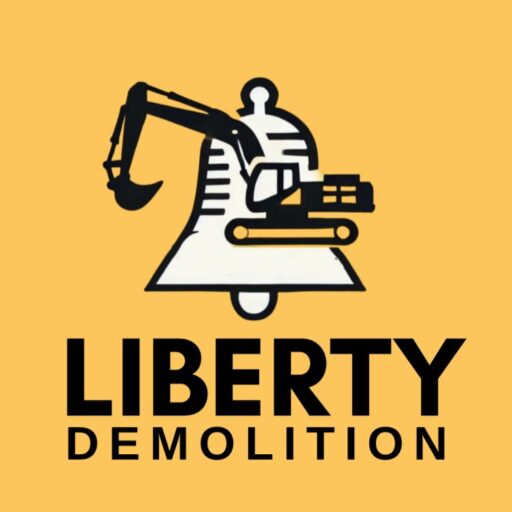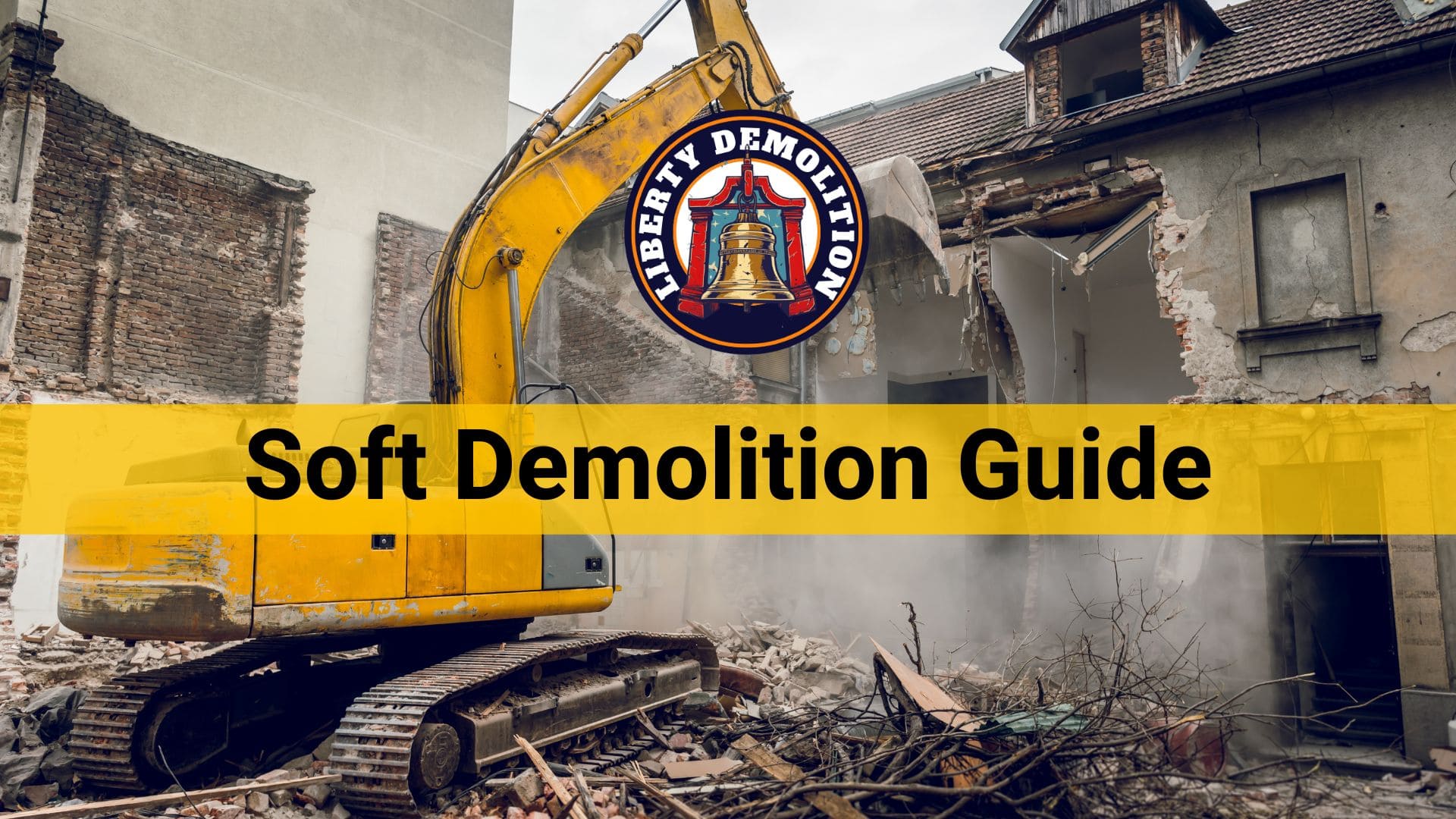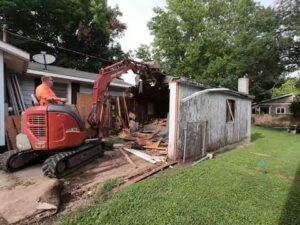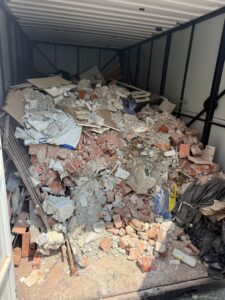Soft demolition, also known as selective demolition, is a process of selectively dismantling specific parts or components of a structure without affecting the overall integrity or causing widespread damage. This method emphasizes safety, sustainability, and precision.
Do you want to learn more? I’ll take you through what you need to know about the process in this up-to-date soft demolition guide.
What is a Soft Demolition?
Soft demolition, contrary to its name, is not a gentle brushing off of structures. It’s a targeted, precision-based procedure where certain sections of a building or structure are deconstructed, leaving the rest undisturbed. Think of it like surgically removing a part of a structure without causing harm to the other parts.
Common Scenarios Requiring Soft Demolition
- Historical Buildings Renovation: Soft demolition is ideal here to preserve the heritage while making necessary adjustments.
- Building Remodeling: Maybe a business needs a larger space, or a homeowner wants a new kitchen. Instead of tearing the whole building down, soft demolition can selectively remove parts to allow for these renovations.
- Infrastructure Overhaul: Soft demolition helps make sure only the damaged parts of roads, bridges, or utilities are dealt with to ensure minimum disruption to the public.
- Environmental Concerns: In areas where environmental protection is a concern, soft demolition ensures that only the necessary parts are removed to reduce potential environmental harm.
- Safety Issues: Soft demolition addresses the problematic sections of a structure without breaking down the whole structure.
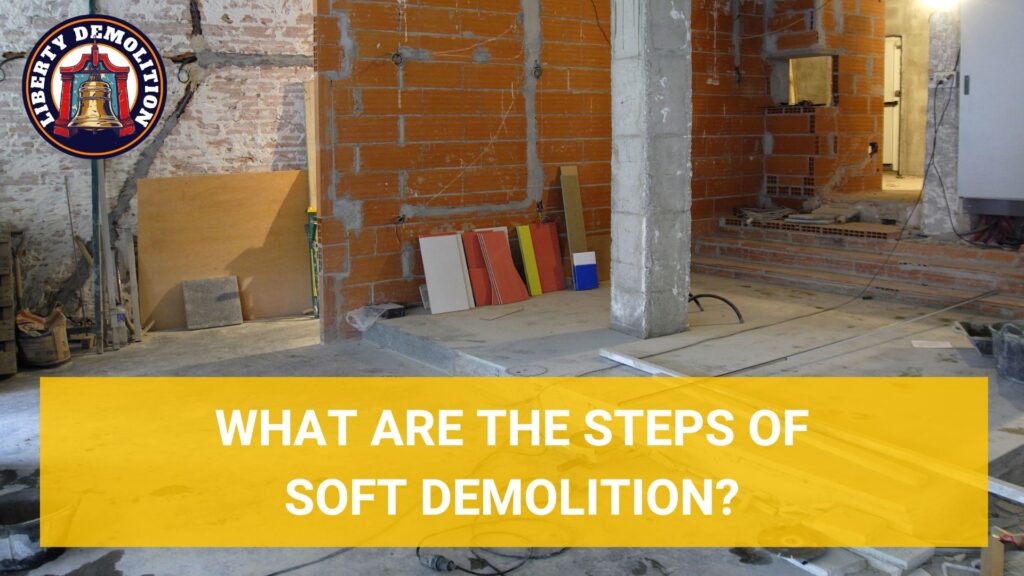
What are the Steps of Soft Demolition?
Soft demolition is a meticulous process that requires careful planning and execution to ensure safety and precision. The following step demolition guide lists out the step-by-step process involved:
Step #1: Prepping the Site
- Assessment and Survey: Experts inspect the site to check the materials used, the structure’s age, potential hazards, and any other specific challenges that may come up during the demolition process.
- Obtaining Permits: This is crucial to avoid legal complications.
- Safety Measures: This step involves setting up barriers, safety nets, or hoardings to protect bystanders and workers and putting up signage that indicates the ongoing demolition.
- Utility Disconnects: It’s essential to ensure no live connections could lead to accidents.
- Relocation of Occupants: If the structure is occupied, arrangements must be made for temporary relocation.
- Equipment and Machinery: It’s crucial to arrange and set up machinery like cranes, bulldozers, or even hand tools, depending on the structure and requirements.
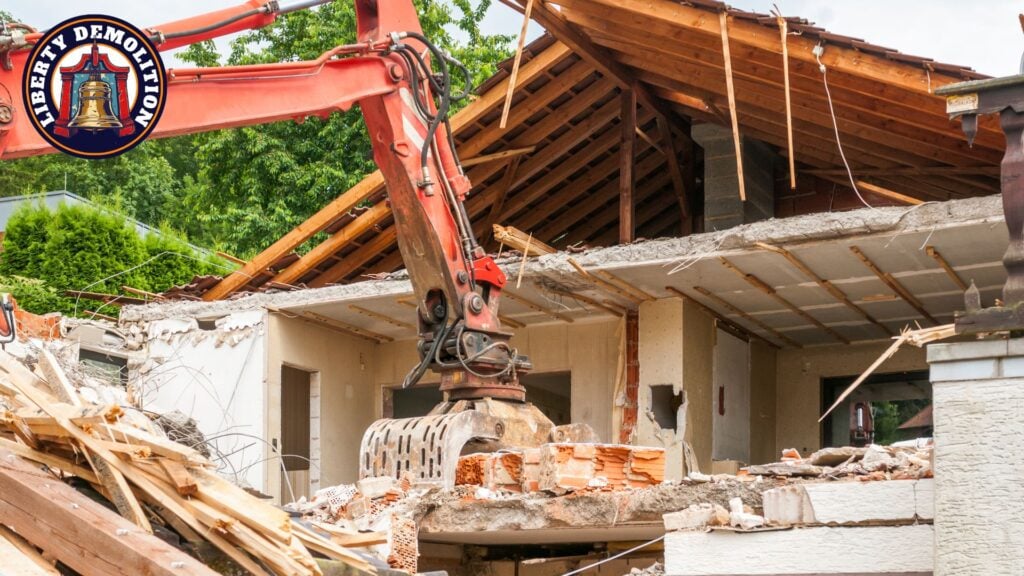
Step #2: Systematic Dismantling of Non-Structural Components
- Identification: The non-structural components, like internal walls, ceilings, or fixtures, don’t play a role in holding up the structure, which makes them the prime targets for soft demolition.
- Order of Dismantling: Components are taken apart in a specific sequence that starts from the top of the building and moves downwards, but it can vary based on the structure.
- Waste Management: Debris could be recycled, reused, or disposed of appropriately, depending on the type.
- Careful Handling: Often, the materials retrieved during soft demolition have monetary or historical value. So, there’s an emphasis on dismantling without causing unnecessary damage.
- Regular Monitoring: Throughout the process, engineers and experts closely monitor proceedings to catch any potential issues before they escalate.
Step #3: Sorting and Categorizing Removed Elements
- Inventory Listing: This inventory or a list of items to be removed provides a reference point, ensuring nothing valuable or reusable gets lost in the chaos.
- Labeling Systems: As items are removed, they are labeled based on their type, material, potential for reuse, and disposal needs. This could be as simple as colored tags or more detailed barcoded systems for larger projects.
- Separation Zones: Dedicated zones are set up on-site to separate different materials.
- Preservation of Valuable Elements: Some elements removed, especially in older structures, may have historical or architectural significance. These items are carefully preserved, sometimes even undergoing restoration to be used in other projects or museums.
- Documentation: Detailed records are kept of what was removed, its condition, where it’s stored, and whether it’s for recycling, reuse, or disposal.
Step #4: Efficient Cleanup and Waste Management
- Dedicated Waste Routes: Specific pathways are established for transporting waste from the site to disposal areas.
- Recycling: Recyclable materials like metals, certain plastics, and glass are sent to dedicated recycling facilities to minimize environmental impact.
- Safe Disposal: For non-recyclable materials or hazardous waste, specialized disposal methods, like transporting them to designated landfills or equipped facilities, are employed.
- Reuse and Repurpose: Materials still in good condition are often repurposed for other projects, sold to salvage yards, or even donated.
- Site Restoration: This step might involve leveling the ground, planting greenery, or preparing the site for its next purpose.
- Monitoring Waste Streams: Monitoring ensures that recyclable materials aren’t accidentally sent to landfills and that hazardous waste is treated appropriately.
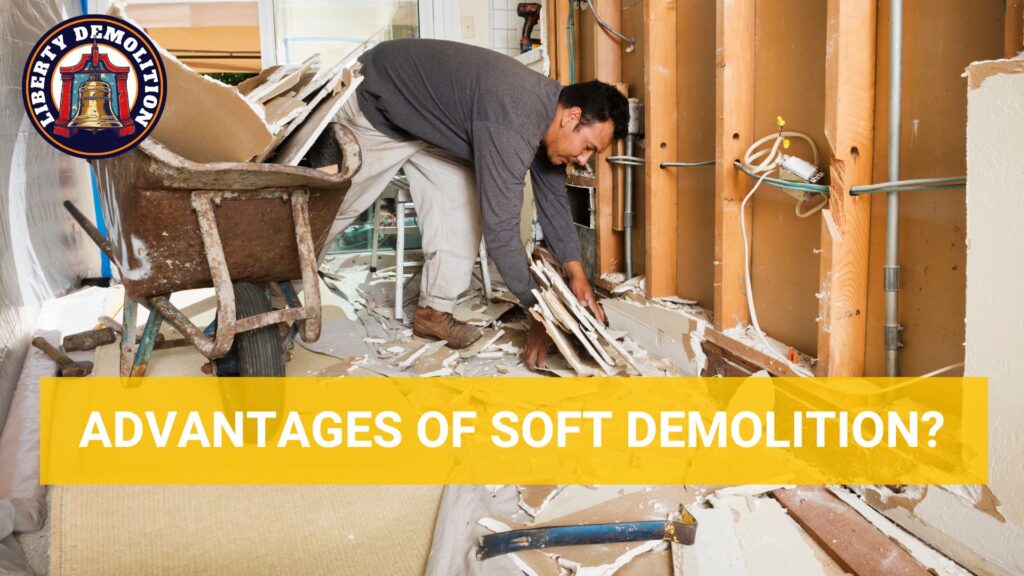
Soft Demolition Guide: Advantages
The term ‘demolition’ often conjures images of bulldozers, rubble, and widespread destruction. Soft demolition, however, offers a calculated approach to deconstruction. It makes sure that the best parts remain untouched while the unnecessary gets removed.
- Preservation of structural integrity
The most significant advantage, and arguably the essence of soft demolition, is the preservation of a structure’s integrity. Traditional demolition methods can sometimes put the entire structure at risk due to unexpected collapses or structural stresses. Soft demolition, being targeted, ensures that only specific sections are removed, maintaining the stability of the remaining structure.
Complete rebuilding can be an expensive affair. By preserving the main structural components, soft demolition can save substantial costs. Moreso, soft demolition typically means lesser noise, fewer vibrations, and overall reduced disruptions.
- Cost-effectiveness
By selectively deconstructing specific parts of a structure, there’s a decrease in the need to purchase new materials for rebuilding. Its targeted approach can reduce the total man-hours needed, thereby reducing labor costs. Soft demolition allows for the careful removal of materials and components. These can sometimes be sold or repurposed, turning potential waste into revenue.
- Eco-friendly benefits
The most obvious benefit is the significant reduction in waste generated. Fewer materials being torn down means fewer materials heading to landfills. By reusing existing structural components, there’s a decrease in the demand for new raw materials. This conserves natural resources and reduces the environmental impact associated with their extraction and processing.
Often, expansion or new constructions might intrude upon green spaces. By utilizing soft demolition, existing structures can be repurposed or expanded upon without the need for additional land, preserving vital green spaces. Traditional demolition can lead to the release of dust and potential pollutants. The targeted and careful nature of soft demolition can reduce this risk, which results in cleaner air and less environmental contamination.
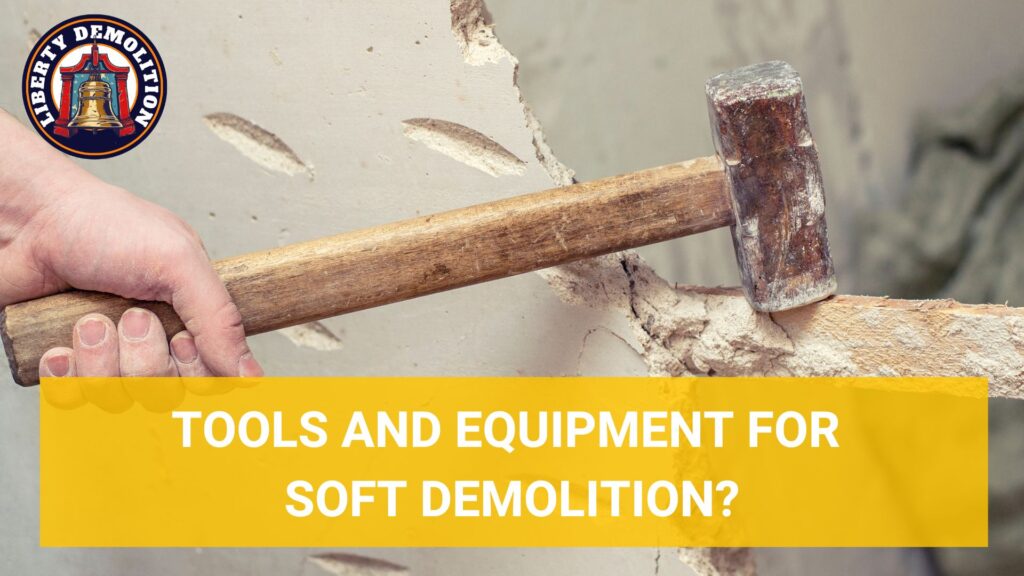
Tools and Equipment for Soft Demolition
The combination of traditional tools and modern equipment, combined with safety gear, allows for a systematic and safe deconstruction process.
Safety Equipment
- Dust masks or respirators
- Safety glasses
- Hard hats
- Ear protection
- Safety gloves
- Steel-toed boots
- High-visibility clothing
- Fall protection (harnesses, safety nets, and guardrails)
- First aid kit
- Fire extinguishers
Hand Tools
- Pry bars
- Hammers
- Screwdrivers
- Chisels
- Utility knives
- Pliers and wrenches
- Tape measure
- Handsaws
Specialized Tools for Delicate Tasks
- Oscillating Multi-Tools: These tools, with their variety of attachments, can cut, sand, or scrape with a high degree of precision.
- Tile Spacers and Lifters: These tools allow for the gentle lifting and removal of individual tiles.
- Nail Pullers: These tools are designed to remove nails cleanly and efficiently.
- Precision Screwdrivers: They are used for delicate fixtures or small components.
- Thermal Imaging Cameras: While not a ‘tool’ in the traditional sense, these cameras can detect areas of heat to help identify live wires or pipes.
- Non-Conductive Tools: They are important to prevent accidental shocks.
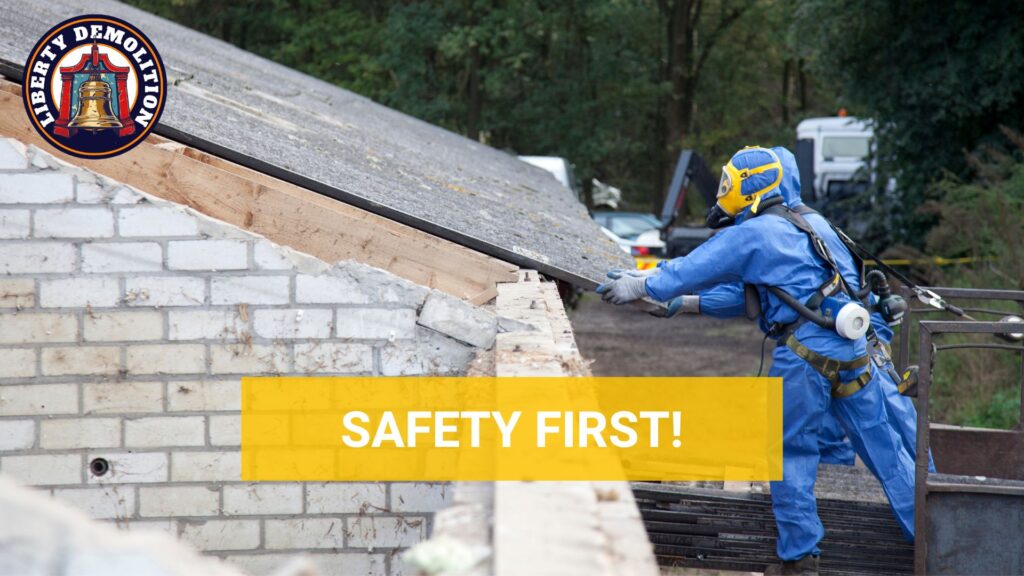
Safety Precautions and Protocols
Effective safety protocols are paramount not only for the workers on-site but also for the integrity of the structure and its surroundings.
Ensuring Minimal Disturbance to the Surrounding Environment
- Dust and Debris Control: Utilize dust barriers, frequent cleanup, and vacuum systems with HEPA filters to keep the air and surroundings clean.
- Noise Management: Schedule noisier operations during times that would cause the least disturbance, and consider using noise barriers or mufflers on equipment.
- Vibration Control: Utilize tools that minimize vibrations and constantly monitor to ensure safety.
- Traffic Management: Establish clear pathways, avoid peak hours for heavy movement, and consider using signage to inform and direct traffic.
Avoiding Hazards like Electrical Wires and Plumbing
- Utility Mapping: Before starting, have a clear map of where all utilities are. This could be from building blueprints, utility companies, or specialized detection tools.
- Power Shutdown: Always ensure that electricity to the area being worked on is shut off.
- Ground-Fault Circuit Interrupters (GFCIs): If power tools are being used, ensure they’re plugged into outlets with GFCIs. These devices will cut off power immediately if there’s an unintended electrical path.
- Water Shut-off: Burst pipes can cause not only a mess but also significant damage.
- Gas Lines: Ensure the gas supply is turned off and be aware of where gas lines run.
- Training: Ensure all personnel on-site are trained to recognize and deal with utility hazards.
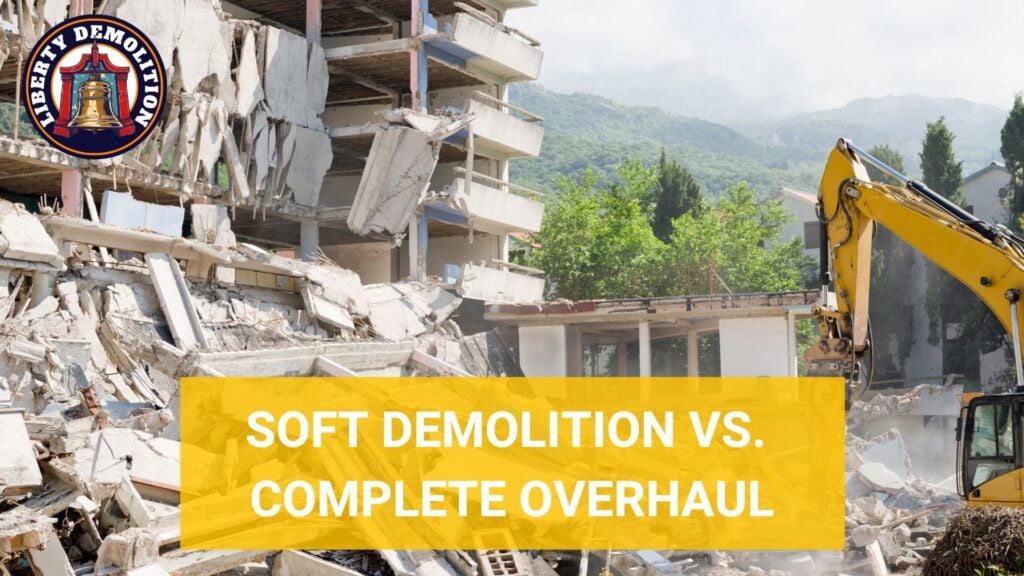
Soft Demolition vs. Complete Overhaul
In any construction and renovation project, decisions can heavily influence short-term and long-term outcomes.
When to Choose Soft Demolition
- If the structure has unique architectural features or historical value
- When only certain sections of a building require updates or changes.
- When the budget is limited
- For projects aiming for a reduced environmental footprint
- If the building’s primary structural elements are in good condition
- Time constraints
Pros and Cons of Both Approaches
This table provides a general comparison, and the actual pros and cons can vary based on specific projects and contexts:
| Soft Demolition | Complete Overhaul | |
| Pros | ||
| Preservation | Retains valuable or historic sections | Offers a clean slate for design |
| Cost Efficiency | Can be cost-effective for minor changes | May be economical for major overhauls |
| Environmental Impact | Less waste due to selective removal | Larger waste, but one-time disposal |
| Time Consumption | Quicker for minor modifications | Lengthier but comprehensive |
| Flexibility | Adaptability for future modifications | Less room for future alterations |
| Cons | ||
| Complexity | Requires meticulous planning | Less complicated |
| Limitations | Can’t change major structural elements | No such constraints |
| Risk | Possible damage to preserved sections | Full clearance mitigates risk |
| Resource Intensity | Can be high due to precision required | Consistent, but intense |
Plan Ahead, Plan Well
Soft demolition involves precision, careful planning, and a deep understanding of structures and environments. With the complexities involved, it becomes crucial to ask the help of professional demolition contractors who know the intricacies of the process inside out.
At Liberty Demolition, we’ve built our reputation on offering unparalleled expertise in executing different types of demolition. Whether it’s Residential, Commercial, Industrial, or Selective demolition, our demolition contractors in Philadelphia approach each project with a deep commitment to safety, environmental responsibility, and utmost customer satisfaction. We don’t just tear down; we provide eco-friendly solutions to ensure waste management and recycling are integrated at every step.
When you think of soft demolition, think of a partner who brings skill, experience, and dedication to every project. Choose Liberty Demolition, where precision meets passion. Reach out to us today!
